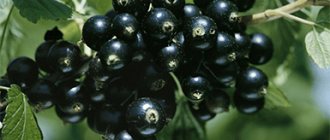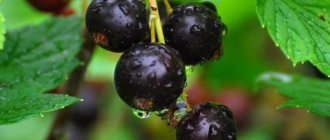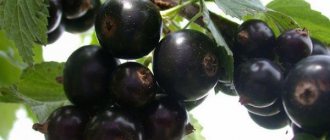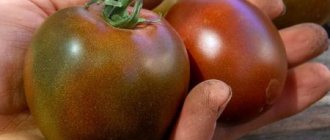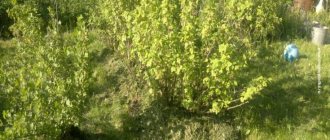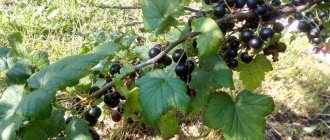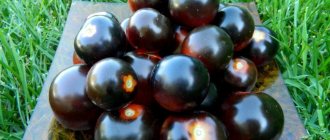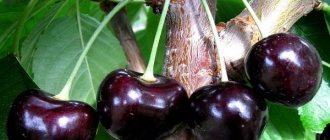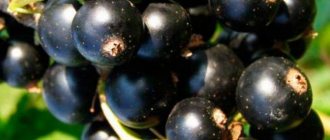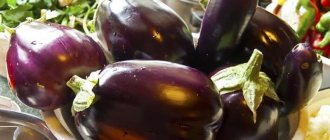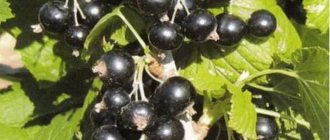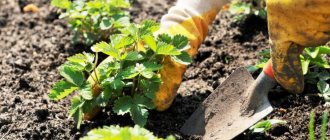Currant Black Pearl: a brief excursion into history
The authors of the variety are T. S. Zvyagina, K. D. Sergeeva. The place where the variety was bred is VNIIS named after. Michurina I.V. How did you get the variety? We crossed 2 varieties of currants: “Minai Shmyrev” and “Bredtorp”.
“Black Pearl” was included in the State. Register in 1992. It began to be grown in the Central Black Earth Region, the Urals, the North Caucasus, the Middle Volga region, and Siberia.
Advantages and disadvantages
Many gardeners fell in love with this variety for the following advantages:
- high content of vitamins and pectin in berries;
- return of stable high yields;
- frost resistance;
- the presence of beautiful golden flowers decorating the area;
- maximum safety during transportation;
- withstand high humidity and sudden temperature changes;
- immunity to anthracnose, kidney mite.
Black pearl is a hardened and winter-hardy variety, because the selection was made in the latitudes of Siberia. But the variety is already considered obsolete due to the development of newer species. Although gardeners still prefer and love it for its many advantages.
Currant Black Pearl: variety description
Currant Black pearl photo
Black currant of the Black Pearl variety is similar in its descriptive characteristics to gooseberries. Currant Black pearl is a golden variety of currant. How are gooseberries and our variety similar? Branches and leaves are inclined downwards. According to reviews from experienced breeders, it can be noted that currant berries are similar to blueberries.
Bush
The bushes reach a height of 1-1.3 meters. It has spreading properties. Young shoots are bright green and have a curved appearance. Over time, they become lignified, the color turns gray with a yellow tint. The buds are elongated, pink in color, and grow on short stems. The flowers are goblet-shaped and have red sepals. Each brush contains 6-8 fruits, located on strong cuttings. The leaves are bright green. The leaf blade has sharp angles and has 5 lobes. The sheet is smooth and matte to the touch, the edges are slightly curved. The teeth are large, like a saw, their ends are white. The bushes themselves have few leaves.
Fruit
Ripens in an average time. Fruit weight - 1.2-1.5 g. Large berries can be 3 g. Berries are in the shape of a circle, of the same size. The taste of the fruit is sweet and sour. Tasting score – 4.2/5 points. The color of the berries is black, shiny, similar to a pearl, hence the name. The pulp with large seeds is covered with a dense skin. What valuable substances are contained in the fruits: 133.3 mg of vitamin C, 1.6% pectin, 3.6% organic acids, 9% sugars, 18% dry elements. When the berries are fully ripe, they are able to hang on the stalks and not fall off for a long time. The place where the currants are picked remains dry, which makes the fruit easy to transport. Cuttings contribute to mechanization when harvesting currants.
The sweetest black currant
Currants are considered the sweetest, containing the largest amount of healthy sugars and the smallest amount of acids. These varieties have a pleasant taste with a slight sourness, as well as high winter hardiness.
Green haze
Variety characteristics:
- average ripening period;
- the berry weighs about 1.5 g;
- yield about 4 kg;
- low maintenance requirements.
The main disadvantage of currants is their susceptibility to pests such as bud mites.
Bagheera
Medium ripening variety with high yield. The berry weighs about 1.5 g and contains 10.8% sugar. Bagheera has many advantages:
- resistance to heat and drought;
- self-pollinating;
- same size of fruits;
- friendly ripening of berries;
- suitability for transportation.
The main disadvantage of the variety is its poor resistance to currant diseases.
The currant berries of the Bagheera variety ripen simultaneously
Pygmy
Characteristic characteristics of the variety:
- large-fruited currants with a berry weight of up to 5 g and a high annual yield;
- the berries have a pronounced currant aroma;
- self-fertility;
- The fruits have a thin peel, so transportability is low;
- It is not susceptible to powdery mildew and anthracnose, but is affected by the bud mite.
Variety characteristics
During breeding work on the variety, a variety was born that is highly valued by gardeners and gardeners. “Black Pearl” inherited the best quality characteristics of its ancestors.
The yield indicator is high and stable. After the plants have been planted in the ground, 1-2 years pass and the variety begins to bear fruit. If you plant plants in the autumn season, then in the summer season you can already see the first harvest. Although it is small (1.5-2 kg), it is already there. Until this moment, naturally, the seedlings must endure wintering and undergo rooting in order to burst into spring flowering with renewed vigor. It takes place in May days. Fruit ripening occurs in the second summer month.
The most productive year of currant life is 5-6. You can collect 5 kg of fruits/bush. The average is 3-4 kg/bush. But there may be more.
Currants are grown in one area for no more than 12-15 years.
Advantages
- Resistant to frost, its “survivability” is observed at temperatures ranging up to -35 degrees.
- It is immune to anthracnose and indifferent to kidney mites.
- It is tolerant of negative weather conditions, such as temperature changes, dry periods.
- It bears fruit for 2-3 years of life, the yield is regular.
- The fruits remain in their original form after they have been transported or frozen.
- Why are currants so hardened and resistant to winter? Because they bred her in Siberia, and this explains everything.
Minuses
Not resistant to powdery mildew. Doesn't smell as bright as I would like. It has a sour taste, which is not for everyone. In general, “Black Pearl” is outdated, because a great variety of varieties have already been bred, which have been improved each time for the better. But you shouldn’t give up on the variety; it is still popular among summer residents due to its many advantageous characteristics.
Characteristic
When cultivating currants, it is very important to take into account its main characteristics. Based on this information, you can make lists of pros and cons in order to build on them when organizing work and preventive measures on the site.
Why do rabbits die for no apparent reason: the main reasons and ways to solve them
Drought resistance, frost resistance
The bushes tolerate frosts well down to -35°C without shelter . Due to the fact that currant rhizomes are located close to the soil surface, drought resistance is low. Given this feature, during cultivation you need to pay more attention to watering.
Productivity and fruiting
The culture is characterized by high rates of precociousness. Already a year after planting, you can harvest the first harvest. On average, you can collect 3–4 kg of berries from a bush. In order to maintain the qualitative and quantitative indicators of the crop at the proper level, rejuvenating pruning must be carried out every season from the 4th year. Otherwise, by 5–7 years the plants will stop producing berries.
Berry size, taste
The berries are medium and large in size, their weight can vary between 1.2–3 g. The fruit has a round, regular shape. They ripen together and stay on the branches for a long time without falling off.
The skin of the fruit is dense, but easy to chew. The pulp is loose in structure, tender, juicy, with large seeds. The aroma is weak. The taste is sweet and sour. On a scale from 1 to 5, the culture received a tasting score of 4.2.
Advantages and disadvantages
- The main advantages of culture:
- high winter hardiness;
- low crown density, which promotes good lighting and ventilation of the bushes and has a beneficial effect on the quality of crop ripening;
- versatility of berries;
- good resistance to diseases and pests;
- self-fertility - this feature allows you to get a harvest even in the absence of bees during the flowering period, plus there is no need to plant several different varieties of currants on the site for cross-pollination;
- the crop tolerates transportation well and loses almost no nutrients when frozen.
- Of the minuses note:
- possibility of infection with powdery mildew;
- high demands on soil moisture.
How can you use the fruits?
Can be eaten fresh. Can be recycled. After you process the berries, they will still be rich in valuable elements.
It is good to use currants in cooking: filling in baked goods, dessert dishes. Jelly, marmalades, preserves, marshmallows, and jams are made from currants, because currants are a storehouse of pectin substances. Also, tinctures and wine are made from the fruits.
Currant leaves are used in canning vegetables; they add richness to their taste and act as a “protection” against spoilage. A tea is brewed from the leaves, which reduces fever and is effective against inflammation. To cure childhood diathesis, tea compresses are made.
Attention! Blackcurrant is prohibited for people whose blood is prone to blood clots. Because currants contain vitamin K, which promotes blood clotting.
Currant Black Pearl: when to plant and where
If you follow agrotechnical rules when planting and properly care for the seedlings, the plants will be healthy and strong, producing a regular generous harvest.
When to plant.
You can plant currants throughout the growing season. If you plant in the autumn season, then the optimal time is the last days of September or the beginning of October. To root the bushes until frosty days arrive, temperature conditions must be at least +10 degrees. Thus, in the second month of summer you can see the first fruits. In the spring season, you need to plant currants until the buds swell. The bush will grow and strengthen for 1 year. Fruiting usually begins in the second year of the plant's life. The harvest from 1 bush is 2 kg of fruit. When purchasing bushes in a nursery, store, or market, inspect them - the roots should be healthy, not frail, there should be 4 buds from the main part of the shoot.
Where to plant plants and how to prepare the place
A place for comfortable living must meet these criteria. An open space, well lit, plenty of sun, without strong gusts of wind. The variety does not like to be in the shade and huddle in close quarters; for these reasons, the branches need a lot of space for free growth. The soil should be saturated with useful substances, loosened, slightly acidic. Seedlings like slightly moist soil. It is forbidden to plant in places where moisture stagnates and in dry areas. The berries will be sour and small if the bushes are planted in a shaded place if they suffer from a lack of moisture.
60 days before planting the plants at the planting site, it is necessary to remove weeds and roots. It is necessary to dig the soil 50 cm deep in order to loosen it and allow moisture and air to pass through. If the soil is depleted of nutrients, this means that you need to add humus or compost fertilizer (a bucket at a time). You can add potassium and superphosphates. If you plant in the spring, then all procedures are carried out in the autumn.
Reproduction methods
Currants can be propagated by woody cuttings. Harvesting planting material can be combined with spring pruning. Select well-ripened, one-year-old, woody shoots with a diameter of 10 mm with several strong buds.
They are cut into cuttings 15 cm long. There should be 3 buds on each cutting. A separate place is allocated for them on the site; they are planted at an angle of 45° at a distance of 30 cm from each other.
The soil is carefully mulched with compost and a temporary shelter is built over the plantings. It can be removed after the first sheets appear. Watering and mulching are carried out throughout the season. Next spring, ready-made seedlings can be planted in the prepared area.
The second method is dividing the bush. It can be used during the period of changing the place for currants. A ten-year-old plant is dug up, then divided and planted in a new place.
Planting rules
If the roots of the plant are a bit dry, they need to be soaked for 2 hours so that they are saturated with water. A drug can be added to the water to stimulate growth in order to strengthen the currant roots.
Work plan for planting
Dig a hole at the planting site. Depth – 0.5 m, width – 0.5 m. If, when you dug up the soil, you did not fertilize it, you need to add fertilizer and mix it with the soil. Fertilizers can include humus, sand, compost fertilizer, and potassium mixtures. Then water the hole to keep the soil moist.
We straighten the root system, plant the plant in the hole, slightly tilt it 45 degrees from the soil. Cover the seedling with soil and shake the roots so that there are no empty spaces. To form new shoots and roots, the root collar should be lowered into the soil 5-7 cm below the surface. Compact the soil around the circumference of the plant, then water with settled water (1 bucket). Trim the tops of the shoots by 10-15 cm, leaving 5-6 green buds.
Place peat, branches, and grass on the surface of the soil. Before unexpected cold snaps, the seedling is covered with dry soil and mulched. The “Black Pearl” variety is planted at temperature conditions not lower than 8 degrees. In this case, the currants will take root successfully and will have a good winter. The interval when planting bushes between each other is 1.5-2 m, because the plants differ in the spreading of their branches.
Landing Features
Black currant Black Pearl is planted in the fall - September-October or in the spring, before budding. The variety is propagated by layering, green and woody cuttings. Seedlings must be healthy, strong, not lethargic. For propagation, you can take a cutting, a young or old bush. Before planting, the plant is kept for 2-3 days in water diluted with growth stimulants. And then the root system can be dipped in a clay mixture for additional protection.
Planting currants photo
For planting, a hole up to 50 cm deep is dug. The distance between the bushes is about 1.5-1.8 meters, because Black Pearl currants are spreading. A bucket of humus (for 2 buckets of soil) and up to 30 g of superphosphate are mixed into simple garden soil. The seedlings are immersed in a hole, deepening the neck by 5 cm, and covered with this fertile soil.
Mulch holds water in the soil and also prevents nutrients like nitrogen from leaching away. But, in addition, weeds are less likely to grow under bushes with mulch.
After planting, the soil is watered with warm water and mulched with humus. The shoots are pruned so that there are no more than 2 buds on each branch above ground level.
Agricultural technology
The shrub will delight you with its fruits regularly if you follow some agrotechnical practices. When plants bloom and bear fruit, they need good watering; 2-3 buckets should be poured under the roots. When preparing the bush for winter, water it with a good amount of water.
When weeds appear near the bush, they must be removed immediately. Removing weeds can be done at the same time as loosening the soil so that it is saturated with oxygen. Just be careful not to damage the roots.
If fertilizing was applied to the soil at the time of planting, it is recommended to feed the bushes after 3-4 years. In the spring season they are fed with urea, in the autumn – with potassium and phosphorus fertilizers.
From time to time the bushes need pruning. The first time the bushes are pruned is when they are planted - 5-6 buds are left on the shoots. Next time, you can trim off broken, diseased and unnecessary branches located at the roots; make new branches short. Shoots over three years old are pruned annually. The formation of the bush is completed at 4-5 years. It must contain branches of different ages.
Advice: there will be no need to loosen, weed, or fertilize the soil with organic matter if the soil around the circumference of the bush is mulched with humus.
Currant Black Pearl: Diseases and harmful insects
Black currants of the Black Pearl variety can be affected by powdery mildew. This is a fungus that attacks young seedlings. Symptoms: a white coating, which later turns into brown, covers the shoots, leaves, fruiting branches; Shedding of greenery and curvature of the plant occur. If you don’t start fighting in a timely manner, the bush will simply die.
How to fight this fungal infection. Copper sulfate will help here. The bushes are treated before they bloom or when the fruits are harvested. Organic fertilizers include mullein or a solution of hay rot. The fertilizer is diluted with water 1:3. Keep the infusion for 3 days and add water, 1:3. The solution must be filtered and the bushes sprayed with a spray bottle. Repeat the procedure - after 15 days and on the 15th of the first summer month.
The fruits of our variety are little susceptible to attacks by harmful insects. But if you care for the bush incorrectly, uninvited guests may come to it: spider mites, aphids, sawflies. The preparations “Fitoferm” and “Dichlorvos” will help you say goodbye to them. If the currants are strong and well-groomed, then you have nothing to be afraid of; rarely will anyone run to see them. The variety is highly resistant to diseases.
Pests and diseases
Currants of the Black Pearl variety can be affected by powdery mildew. This is a fungal disease that usually affects young bushes. Shoots, leaves and fruit branches are covered with a white coating, which over time changes color to brown. The greens fall off, and the currants become crooked. If measures are not taken in time, the plant will die.
Copper sulfate is used to combat powdery mildew. Gardeners treat Black Pearl shrubs before flowering or after harvest. Among non-chemical remedies, an infusion of mullein or hay dust is popular. The mixture is diluted with water in a ratio of 1 to 3. Leave for three days and add the same amount of water. The resulting infusion is filtered and the currants are sprayed with a spray bottle. Repeat after 15 days and in mid-June.
Typically, Black Pearl berries are rarely attacked by pests. But if not properly cared for, spider mites, aphids or sawflies can settle on its bush. You can get rid of them using special preparations, for example, “Fitoferm” or “Dichlorvos”.
Well-groomed and strong currants are rarely attacked by pests; they have good immunity to diseases.
Currant Black Pearl: reviews from gardeners
Natalya, 24 years old, Nizhny Novgorod : “As for me, this is a wonderful variety, which is what I focused my attention on. He pleased with his frost resistance; he does not need special care. The fruits are sweet, this is a significant aspect; I don’t like sour currants. I bake cakes, I constantly add currants to the filling, this is my trick. And people like it."
Vladimir, 54 years old, Sterlitamak : “I bought 2 bushes of this variety, for some reason I was guided by the name. I don’t regret anything, because currants live up to the name. The fruits are large, like black beads. The bushes do not require special care and produce a rich harvest, despite the weather.”
Tatyana, 36 years old, Saratov : “This is my favorite variety of currant, time-tested. When the berries are ripe, they remain on the bush for a long time and do not fall off. Over time they resemble raisins. The berries are not that big, but they are sweet and tasty.”
Currant Black Pearl is an obsolete variety, because a great many new and more developed varieties have been bred. But among summer residents, the variety is still valued and grown, since the plant is proven.
Care and harvesting
We recommend reading our other articles
- Goose eggs
- Potato variety Impala
- What grain to feed laying hens
- High Line chicken breed
Black Pearl currants are distinguished by large, beautiful berries. To collect them in abundance, it is important to take timely measures to care for the bushes.
Currant harvest photo
- Watering should not be frequent, but plentiful. About 2 buckets of water are poured under the bush at a time. Water once a week, not more often.
- Loosening the soil is necessary so that oxygen penetrates the soil, to the roots. This is done with a not very sharp hoe so as not to damage the roots!
- Mulching is necessary so that the bushes can be watered less often and to increase the nutritional value of the soil. Some gardeners do without mulching, so this is not a necessary care item.
- Weeds are removed as they grow. It is advisable to immediately pull them up by the roots, collect them and take them out of the area, and when they dry out, burn them.
- Fertilizing with superphosphates, potassium chloride and nitrogen substances, as well as organic fertilizers is carried out from the third year after planting. In the spring, add urea or other nitrogenous substances according to the instructions. And in the fall, it won’t hurt to add phosphorus and potassium to the soil before digging – you can replace it with simple humus.
- Treatment for pests and diseases is carried out as the problem appears. But if you don’t want to get acquainted with all possible crop diseases, you can carry out preventive treatments with complex insecticides and fungicides 2 times a year.
- Pruning is done in late autumn. In the spring, after the frosts have passed, it doesn’t hurt to inspect the bush for frozen branches that should be removed. Every year you need to cut off branches older than 3 years to rejuvenate the bush and prolong its fruiting.
After harvesting, you need to start processing or selling it. Black Pearl currants last well, but not for very long - after all, these are currants, not apples. It is consumed fresh for health purposes. The harvest can be frozen - in winter, delicious compotes, smoothies, and pies are prepared from the berries. High quality jams, jams, compotes and even juices are obtained from this variety, but only with the addition of sugar or other, sweeter berries (cherries, strawberries, grapes).
